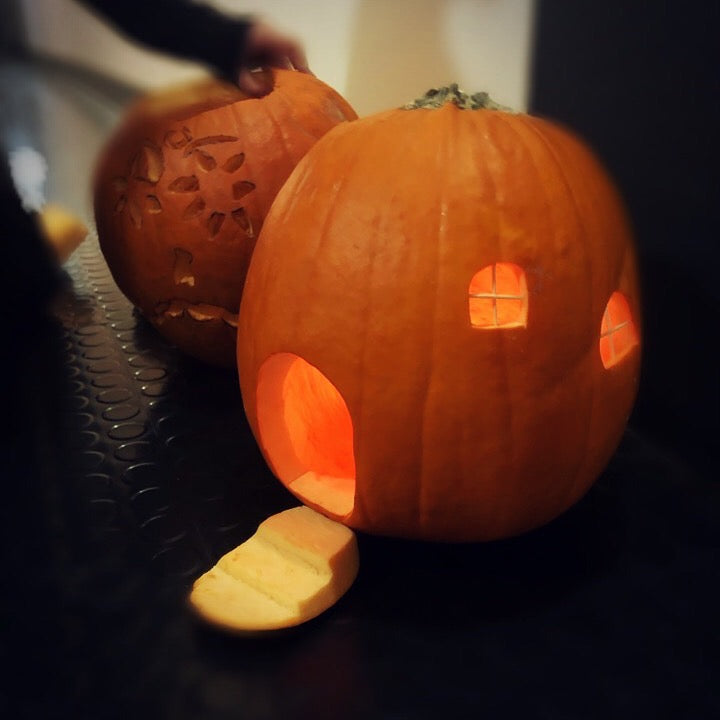That depends on a few things...
I think most people can agree on the basics of Halloween: costumes + candy almost always equals good. But if you’ve ever had to check under the bed, behind the curtains or in the closet at bedtime (either for a little one or for yourself) you might feel a bit differently about some of the other parts of Halloween.
The TLDR version: Yes, it is possible to enjoy a spooky surprise without being too scared. The key is mystery. Feel free to jump to the end for some ideas.
Some accounts of the origins of our Halloween traditions say that dressing up in costume was a way to confuse the ghosts and spirits that would visit the earthly plane on that night, so they wouldn't be able to tell you were a mortal. Over the centuries, we have done our best to leave out the scariest parts of this ritual for kids, and for good reason. Fear is a perfectly rational response to a feeling of being unsafe, one that is rooted in our basic instincts for survival.
So why do we love a good scary story? And if we love to be scared, then why do we put so much effort into making things not too scary for kids? While a set of googly eyes can make ghosts and spiders cute, they don't always manage to take the scare out of everything. Full disclosure: I would put googly eyes on anything. They're the best and I always have a ready supply on hand.
But I think the answer to a 'good' scare is a bit more complicated, and might have more to do with being surprised rather than scared. A feeling of surprise is different: it's a reaction to something unexpected or astonishing. It often has a physiological component as well, and here's the neat part -- it is a neutral experience in and of itself. That means it can be pleasant or unpleasant, positive or negative, depending on the situation (and of course, on the person being surprised).
Imagination is a powerful thing, and for kids even more so, as they haven't yet learned to tell the difference between the real and the imagined. They also haven't had the opportunity to test this boundary, or really to know what to expect from others outside their immediate families. So there's a fine line between the excitement of a spooky Halloween, and the sleepless nights that might follow, especially for kids (and grown-ups) with a healthy and active imagination... (and to all the people that have said I have an 'overactive' imagination, I said good day!)
This can be a tricky line to walk, in part, because there are so many kinds of imagination at play here -- it's not just that you remember what you've seen, but also what happens next, when your mind takes that vision and actively constructs something new with it. This might be by combining different memories together, by following or even distorting a logical course of events that might occur, or by inventing the rest of the story yourself. Add to this the effect of empathy on our imaginations.
The ability to understand or feel what someone else feels is exactly how we know to be afraid.
For anyone cursed with a strong visual sense (raising my hand here), you can't overlook the impact of being able to 'see' it played out, over and over in your mind. All the details, all the colours, all the textures... This can quickly become overwhelming, and decidedly unpleasant when you're desperately trying to get the recommended amount of sleep at night.

So what is a somewhat-fearful-Halloween-loving parent to do??
Don't worry, there is a sweet spot between surprised and scared: it is called mystery. There is nothing like a puzzle to solve with an unexpected twist at any time of year, but Halloween presents some near perfect opportunities to exercise those parts of our imaginations with wild abandon. One of the best things about the way imagination works is the way it can fill in gaps. And while this may result in the wrong ingredients being purchased at the store, it also might explain the enduring hilarity of things like MadLibs, which will forever be a dinner-time favourite around here.
So we thought we would share a few of our favourite ideas to try this Halloween. Who knows, you might spark a new interest in a budding mystery writer, or even start a new family tradition.
The objective, as always, is to let your kids come up with their own stories, and this is most important: it is much harder to cross the 'too scary' line when you are relying on your own imagination to construct the story, rather than hearing it from someone else. This is also why scary stories in books are not at all the same as scary stories in movies. In a book, your imagination can do all the heavy lifting, and has to rely on things it already knows to construct an understanding. In a movie, your imagination doesn't have to do any work at all. It is being presented with images and ideas that may be completely new to you, and without understanding them, imaginations can have a tough time piecing these together with what they already know.
If you really get into it, you could invent a whole back-story and draw the fun out for weeks leading up to Halloween. Or you could start small. Often the biggest stories come from the smallest seeds. This is in no way an exhaustive list, but just some ideas to get you going.
1. Strange tiny things.
Leave a little collection of tiny things somewhere for the kids to stumble on. This works best when the objects don't have an obvious connection to one another, so you have to imagine how they might be used together. Try to imagine how they got there? Who do they belong to? Are they coming back to collect them? Why did they get left behind? Was someone in a hurry, or did they leave them here especially for us to find? Did they appear magically out of thin air?
Some ideas for objects to use could include a thimble, empty spools, acorn caps, brightly coloured string, a tiny sock or shoe from a dollhouse, the lid of a jar or bottle, some dried beans, a little pile of shredded paper, a tiny cup from a tea set, gears or springs from a broken toy, a candle, empty wrappers, a cookie with a bite out of it...
Try placing them strategically to lead to more searching, or to wondering what's behind or under there? Beside a pantry or cupboard door, on the cushion of a couch, at the foot of a bed, on a window ledge or fireplace mantle, peeking out from under the stove or fridge, near the cereal box, in a bowl in the cupboard, on a nightstand, tucked somewhere into a bookshelf, an obvious lump under a rug.
2. A strange door.
Make a little door and attach it to a tree outside. It should be low enough to be seen, but high enough that the kids can't reach. This will give them more opportunity to imagine what's behind it, where it came from, who could live there...
3. A mystery letter.
Write a letter and mail it to your kids, asking for their help in solving a mystery. There are some great services that will do this for you, like Mail Order Mystery you can also try your hand at creating your own story. Again, you often only need to worry about the beginning, as your kids' imaginations will take over and run with it.
4. Mysterious clues.
This requires a bit of planning ahead, but if you have a familiar hike or walk that you take together, have someone go earlier and place a few clues to find along the way, kind of like a treasure hunt that you don't know you're on... Things could be placed in the hollow of a tree, you could leave a trail of sparkles or something eye catching from different tree branches to follow, giving the sense that they're being drawn into a mystery.
5. A knock on the door.
Enlist the help of a neighbour or friend to knock on the front or back door around the same time each evening. They would have to be a fast-moving friend able to hide before anyone answered the door. If you were really keen, you might give them a series of things to leave on the doorstep (or do this yourself). Again, these could be Halloween themed objects, an interesting collection of random things that cause your kids to wonder what is going on, or a logical progression of pieces to a puzzle to solve. Just be sure to let them construct their own version of the story.
6. A roaming spoon.
Choose one unusual object. It could be something familiar to everyone (like a specific wooden spoon, for instance) or it could be something brand new that no one has ever encountered (like an interesting looking key or something found in a little antique shop). Leave it in an obvious place for them to find, but not one where you would expect it. So a wooden spoon on the bathroom counter, for example. Then each day, move it to a different place in your house. It might even make its way to school in a back-pack or under someone's pillow one night.
7. A magic box.
Find an old jewellery box or something similar at an antique store and have it arrive mysteriously on the doorstep. Bring it inside and open it with your kids to find it empty. Imaginations will start wondering where this could have come from. Place the box somewhere central like a coffee table or kitchen table, and then the next day, when someone goes to move it they will notice that there's something in it. If you want to keep this going, you can have something new appear in the box each day, or you can make it really fun by timing the new apparitions with something that's happening in real life. For example, you could make a point of talking about wanting to bake tomorrow, and then the next day find a recipe card in the box.
These are just a few ideas to get you started. There are so many ways to plant a little seed that can grow into a much larger story, and you will be amazed to watch what your kids can do with just the littlest spark of imagination, even long after Halloween is over.
You know we love a good story!
Please let us know if you try any of these ideas, or have some of your own to share in the comments below...
Happy Halloween!
xx gogo and martin


Leave a comment